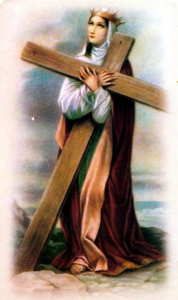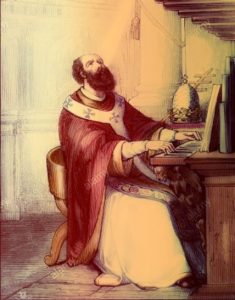 Saint Helena
Saint Helena
Empress (c.246 – c.330)
Feast – August 18
But she will be saved through motherhood, provided women persevere in faith and love and holiness, with self-control.(1Timothy 2:15)
Constantine the Great was the Emperor of Rome from AD 306 to 337. Born in Naissus, Dacia Mediterranea (now Niš, Serbia); he was the son of Flavius Constantius, a Roman army officer of Illyrians (peoples who inhabited the western Balkan Peninsula) and Roman emperor from 305 to 306; and Flavia Julia Helena, today known as St. Helena. Constantine was the first emperor to convert to Christianity. He played an influential role in the proclamation of the Edict of Milan in 313, which declared tolerance for Christianity in the Roman Empire. He convoked the First Council of Nicaea in 325 which produced the statement of Christian belief known as the Nicene Creed. Historians have recognized St. Helena’s great influence on her son.
Very little is known about her early life. It was the pious boast of the city of Colchester, England, for many ages, that St. Helena was born within its walls, others say she was born in York and was a British princess who married a Roman General, Constantius Chlorus.
Since the name Helena was typical for the Greek-speaking part of the Roman Empire, it is believed that St. Helena was born in c. AD 246 in the Greek city of Drepanon, Bithynia, in Asia Minor (modern Turkey) which was renamed Helenopolis in her honor. St. Ambrose described her as a “good stable-maid”, which may suggest that she was born into a lower class in the Roman culture of the day, but the words of St. Ambrose, a doctor of the Church, should be rather understood as – good, stable in faith, maid of the Lord.
She met Constantius while he was serving under Emperor Aurelian in Asia Minor for the 272 campaigns against Zenobia, the queen of the Palmyrene Empire of Syria. It is said that upon meeting they were wearing identical silver bracelets. Constantius saw her as his soulmate sent by God and soon thereafter they got married. Around the year 274, their only child, Constantine, was born. Fifteen years later Constantius, to strengthen his political position, divorced St. Helena and married Theodora, the step-daughter of Emperor Maximinianus. In 305 Flavius Valerius Constantius “Chlorus” became Roman Emperor Constantius I. He ruled alongside Emperor Galerius, splitting the empire into West and East, while Severus II & Maximinus II served as Caesars according to a power sharing arrangement known as the Tetrarchy. The eastern and western provinces would each be ruled by an Emperor known as an augustus (administrator), supported by a Caesar (military commander). Both Caesars had the right of succession once the ruling augustus died.
Constantius died a year later during a campaign in Britain against the Picts. As he was dying, he recommended his son Constantine to the army as his successor. consequently, Constantine was declared emperor by the legions at York. This caused a shift in the political situation in the Empire. Severus II took over as Augusti from Constantius, and Constantine I supplanted him as a Caesar. Meanwhile, in Italy and Africa Maxentius & Maximian began their attempt to usurp the throne.
After the divorce, St. Helena lived in obscurity, though close to her only son. Constantine was forever loyal to his dear mother, whom he loved very much, never leaving her side. In 307 when Constantine became Emperor he summoned his mother back into inner circle and the imperial court. St. Helena received the title of Augusta (title given to empresses and honored women of the imperial families) and unlimited access to the imperial treasury. He even had coins minted, bearing her image.
Her faith and piety greatly influenced Constantine and served to kindle a holy zeal in the hearts of the Roman people. Forgetful of her high dignity, she delighted to assist at the Divine Office amid the poor, and by her alms deeds showed herself a mother to the needy and distressed.
In the year 312, St. Helena’s motherly work bore fruit of great magnitude.
Maxentius (son of the former Emperor Maximian) and others had initiated a civil war against the Tetrarchy. To protect the country, Constantine had mobilized his forces. On October 28th, 312 AD, near the Milvian Bridge, an important crossing of the Tiber river, Maxentius attacked Constantine’s forces. Vastly outnumbered, Constantine knelt and prayed, asking God to reveal Himself as the supreme God by giving him an otherwise impossible victory. Abruptly at noonday, a cross of fire was seen by his army in the calm and cloudless sky, and beneath it the words: “In hoc signo vinces” which translates to: In this sign thou shalt conquer. Under the Christian banner known as the Roman Labarum they the enemy was crushed, victory was secured and the first Christian empire was born.
In her eighties, between the years 326-328, St. Helena made a famous pilgrimage to Jerusalem.
Sixty years after Titus’ destruction of Jerusalem in 70, around the year 130, Emperor Hadrian had built over the site of Jesus’ death a temple dedicated to Venus. During this pilgrimage, she ordered the temple torn down and chose a site in this location to be excavated. This led to the discovery of three crosses together with the names and inscription recorded by the Evangelists. The miraculous discovery and verification of the true Cross is celebrated by the Church on the 3rd of May.
To determine which cross was the True Cross, if any, the empress performed a test. Possibly through Bishop Macarius of Jerusalem, she had a woman who was near death brought from the city. When the woman touched the first and second crosses, her condition did not change, but when she touched the third cross she suddenly recovered, and St. Helena declared the third cross to be the True Cross on which our Blessed Redeemer had suffered. Upon this discovery, Constantine ordered a beautiful Basilica on Mount Calvary to be built to receive the precious relic.
She had two other famous churches built in Palestine to honor the sacred sites of Our Lord’s life: the Basilica of the Nativity in Bethlehem and the Church of Eleona (Greek for olive grove) over a cave on the Mount of Olives. The Church of Eleona is sometimes called the Church of the Disciples.
Theodoret of Cyrus, an influential theologian, wrote that that during her search, St. Helena also discovered the nails of the crucifixion. She had one of the nails placed in Constantine’s helmet and one in the bridle of his horse to aid him with their miraculous powers. Several of the relics believed to be found by St. Helena are located in Cyprus. Among these are parts of Jesus’ tunic and pieces of the rope used to tie Him to the cross. When she returned to Rome from Jerusalem in 327, she brought parts of the True Cross back with her. She stored these in her palace’s chapel. They can still be seen to this day, though her palace has been converted to the Basilica of the Holy Cross in Jerusalem.
St. Helena died around 330 with her dearly devoted son by her side. She was then buried in the Mausoleum of Helena outside of Rome. Her sarcophagus can be seen in the Pio-Clementine Vatican Museum.
References and Excerpts:
[1] C. Online, “St. Helena – Saints & Angels,” Catholic Online. https://www.catholic.org/saints/saint.php?saint_id=123 (accessed Aug. 05, 2023).
[2] “Saint Helen, Empress.” https://sanctoral.com/en/saints/saint_helen.html (accessed Aug. 05, 2023).
[3] “Helena, mother of Constantine I,” Wikipedia. Jul. 09, 2023. Accessed: Aug. 05, 2023. [Online]. Available: https://en.wikipedia.org/w/index.php?title=Helena,_mother_of_Constantine_I&oldid=1164579365
 Saint Leo II
Saint Leo II